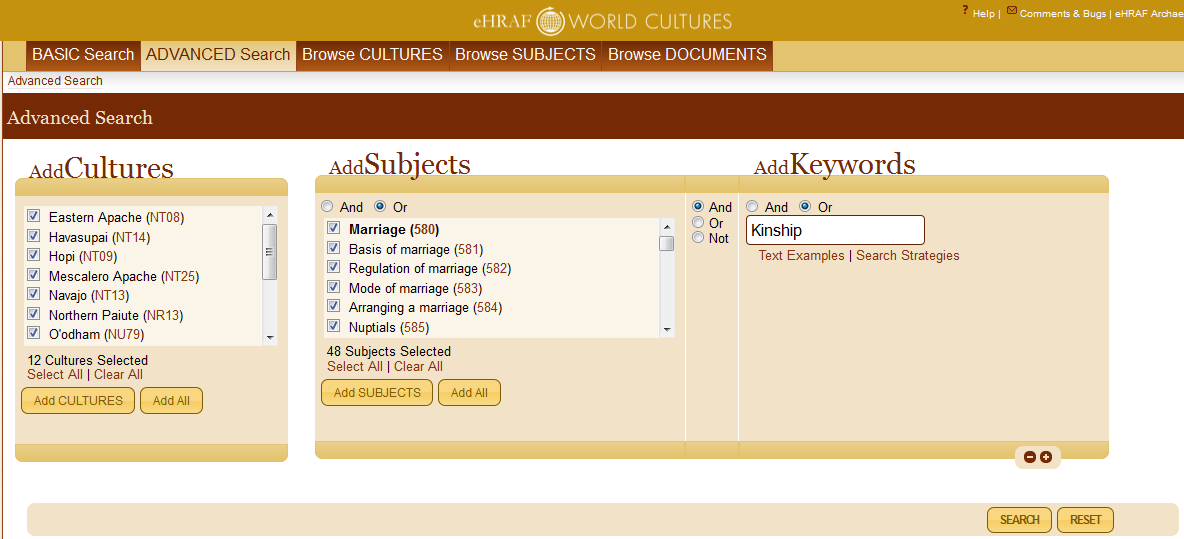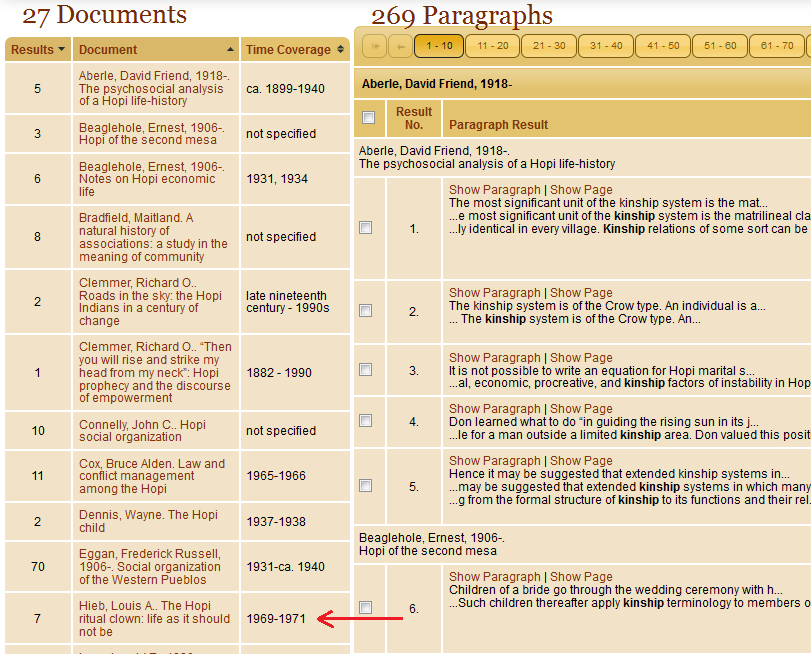Return to Teaching eHRAF: Tile View | Table View
View exercise overview
Class size: Large 50+
Source: Submitted by HRAF member
Learning Objectives
Does the exercise compare 2 or more cultures? No
Subject selection: Single subject specified by teacher
Subjects/OCMS, if applicable: Kinship
Region selection: pre-selected
Region, if applicable: North America
Culture selection: Set by teacher
Cultures/OWCs, if applicable: Hopi
Samples:
Classroom Guide
Instructions for navigating eHRAF included? Yes
Assignments for students to complete in groups? No
Assignments for students to complete on their own? Yes
Instructions for Microfiche version? No
Kathryn M. Koziol, Department of Anthropology, University of Arkansas
*Note to Instructors*: This assignment is suitable for teaching large anthropology classes. The questions draw from specific text document results of Advanced Searches in eHRAF World Cultures. At the end of the assignment, general questions about the eHRAF database are drawn from the HRAF’s homepage. An Answer Key for this assignment is available here. The Answer Key is password protected. Instructors can email hraf@yale.edu to request the password.
Among the Hopi, clan membership is very important for a number of reasons. For this assignment, you will be using a specific textual description available in the eHRAF World Cultures database that describes Hopi kinship and clan life. You will also encounter a discussion about egalitarianism that you will need to assess.
Directions
To find the source materials in the eHRAF World Cultures database:
1. Log on to eHRAF World Cultures through your institution’s online library or at the HRAF homepage (hraf.yale.edu) by clicking on the brown button labelled “eHRAF World Cultures” under Access the Databases in the right-hand margin of the page.
2. Once logged on to the eHRAF World Cultures database, click on the Advanced Search tab.
3. Using the Add Cultures function, choose North America as your cultural area. Next, specify Southwest and Basin. The culture names should appear as a list in Advanced Search.
4. Using the Add Subjects function, choose your subject (in this case, use the Marriage, Family, Kinship, and Social Organization subject tree). Be sure to keep the circle above the subject choice set to “Or” so that it the search will include at least one, but not all, of the marriage, family, kinship, and social organization topics.
5, In the keyword box, type “kinship”.
6. Click Search to launch your cross-cultural search for the cultures in the Southwest and Basin region of North America and to reach the ethnographic works for the Hopi culture.
 Note that the search results in 1095 paragraphs in 155 documents in 12 cultures. You now will select the Hopi (OWC: NT09). Specifically, you will be working primarily with the text located on pages 123-127 from:
Note that the search results in 1095 paragraphs in 155 documents in 12 cultures. You now will select the Hopi (OWC: NT09). Specifically, you will be working primarily with the text located on pages 123-127 from:
Hieb, Louis A. 1972. The Hopi ritual clown: life as it should not be. Ann Arbor, Michigan: University Microfilms.
 Note that there are 27 documents.
Note that there are 27 documents.
Select Louis Hieb as the author of your document, then select the first displayed result from Hieb (result 119). Click “Show Page”. This will bring you to page 123.
 Verify that you are working with the correct source before you proceed.
Verify that you are working with the correct source before you proceed.
Questions -25 Total Points
1. What is the document ID for this source? Hint, you might want to peck around for some of the background/publication information to find this information. 1/25 points
2. What is the place coverage listed for this data? 1/25 points
3. What is the field date listed for this data? 1/25 points
4. What is the culture listed? 1/25 points
Now answer the following questions beginning on the selection page 123. There is enough information in this section to apply your knowledge of the class materials and figure out the answers to questions below that are not specifically stated by Hieb (1972). Questions marked with an asterisk (*) will require you to perform an additional search.
5. How is Hopi kinship traced? (i.e., bilateral, matrilineal, patrilineal, etc.) 1/25 points
6. Name two ways in which clans are important in Hopi life according to the citation from Eggan that is included on page 123. 1/25 points
7. What does it mean to be egalitarian? Try to put it into your own words. 1/25 points
8. According to Hieb, are the Hopi egalitarian? Why or why not? Be sure that you have read pages 124-127 prior to answering. 2/25 points
9. What does the term exogamy mean? Try to put it into your own words.1/25 points
10. What do you think Hieb (page 123) means when he says “The phratry is the largest exogamic unit but it has no economic, ritual or political significance.” Think of the phratry as a larger collection of related clans. For example, under the Eagle phratry you would include the Eagle Clan, the Hawk Clans (red and gray), and other related clans not named in the text.1/25 points
11. What is kahopi? Try to put this in your own words, though you may also include the description from the text on page 124. 1/25 points
12. Which clan holds the highest prestige among the Hopi? 1/25 points
13. Why is the Spider Clan holding the most prestige in Walpi village? 1/25 points
14. What types of privileges are associated with membership in the Bear Phratry (collection of related clans) membership?1
15. Name 3 Hopi clans other than the Bear Clan that Hieb mentions in the eHRAF text. 1/25 points
6. *What is an arroyo? You will need to complete this question using a search engine like Bing or Google and you need to provide the URL of the website that you visited to find the answer to receive credit. 1/25 points
17. Draw a matrilineal kinship diagram. You must have at least 3 generations represented and you must include at least 15 individuals. You may use colors or shadings in your diagram. You must use the symbols that you learned in lecture and drill (i.e., triangles, circles, downward brackets, etc.). 3/25 points
General Questions about the HRAF and the eHRAF World Cultures database: Students should be able to answer these after your eHRAF overview in your drill section. They can also find this information on the HRAF homepage at https://hraf.yale.edu.
18. What is the HRAF and when was this system founded? 1/25 points
19. What does the acronym OCM stand for and how does it work? 1/25 points
20. Next, find a list of the OCM subject codes. This is provided on the HRAF homepage at https://hraf.yale.edu in multiple locations (i.e., as a pdf, as a searchable list, etc.). Provide the OCM subject codes for the following topics: 1/25 points
Mnemonic Devices: ______
Leather Industry: ______
Labor and Leisure: ______
Athletic Sports: ______
21. What are the eight regions associated with the culture names found in the eHRAF World Cultures database or found in HRAF’s homepage? *Hint, you might want to think about the search that you performed in the eHRAF World Cultures database to access the Hieb text. 1/25 points
22. How many different cultural, ethnic, religious, and national groups are represented in the various HRAF formats (print, microfiche, CD, and online)? Hint, this type of information can be found on HRAF’s homepage and would include descriptions of what the original HRAF Collection of Ethnography was created for. 1/25 points
Cultures in the various HRAF formats: _____
______